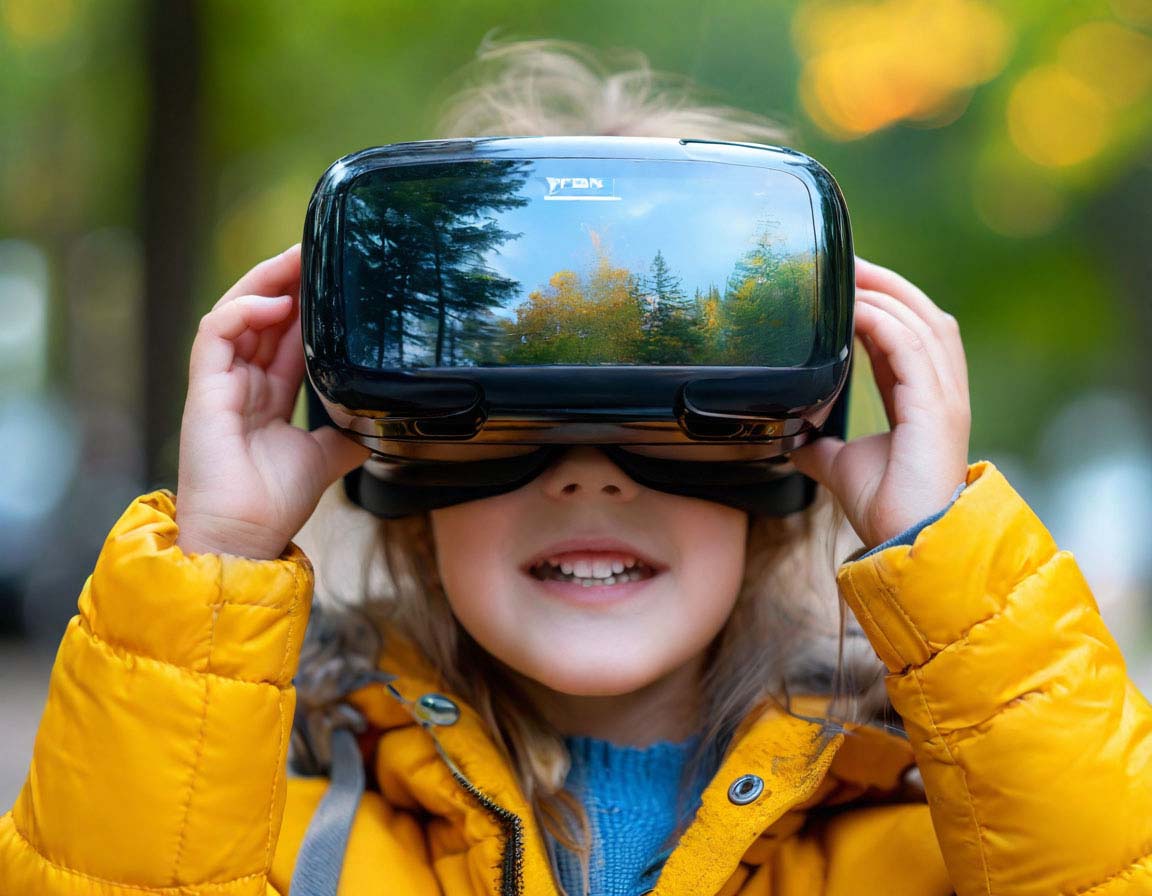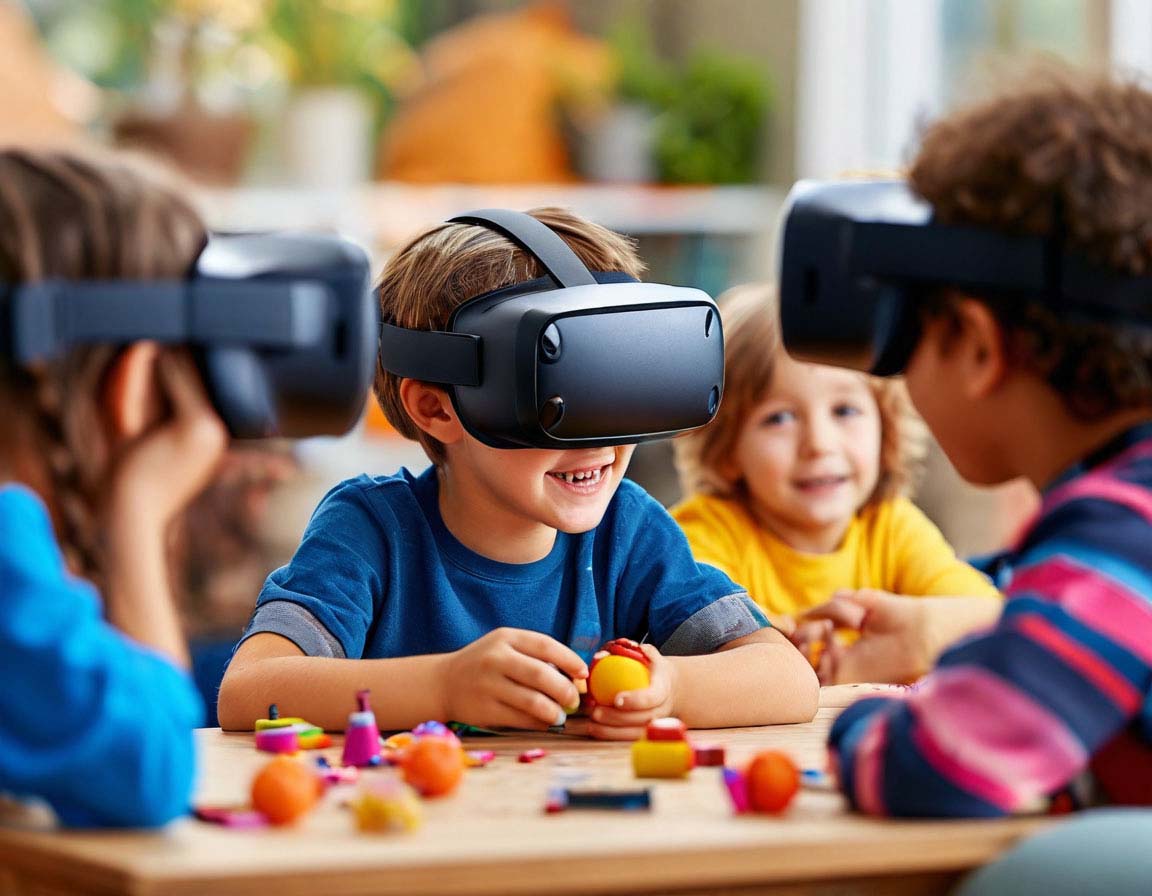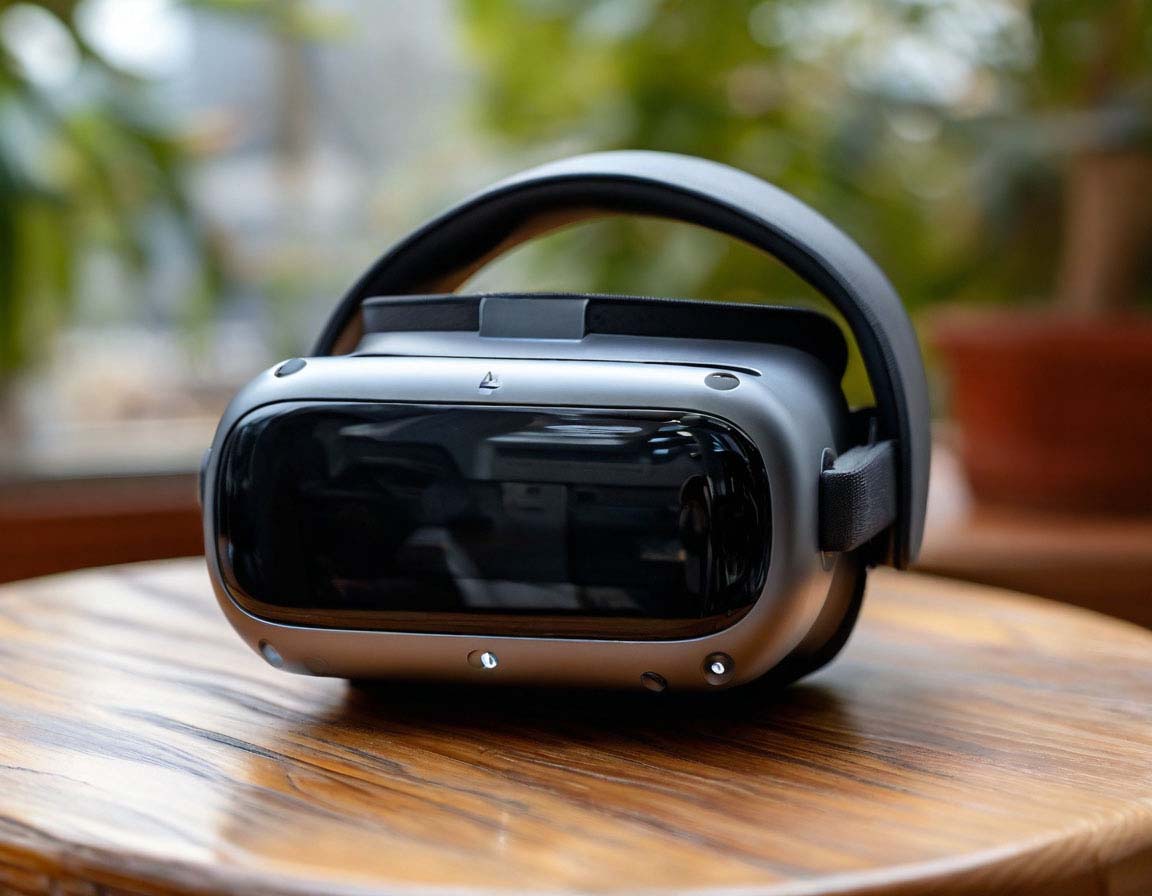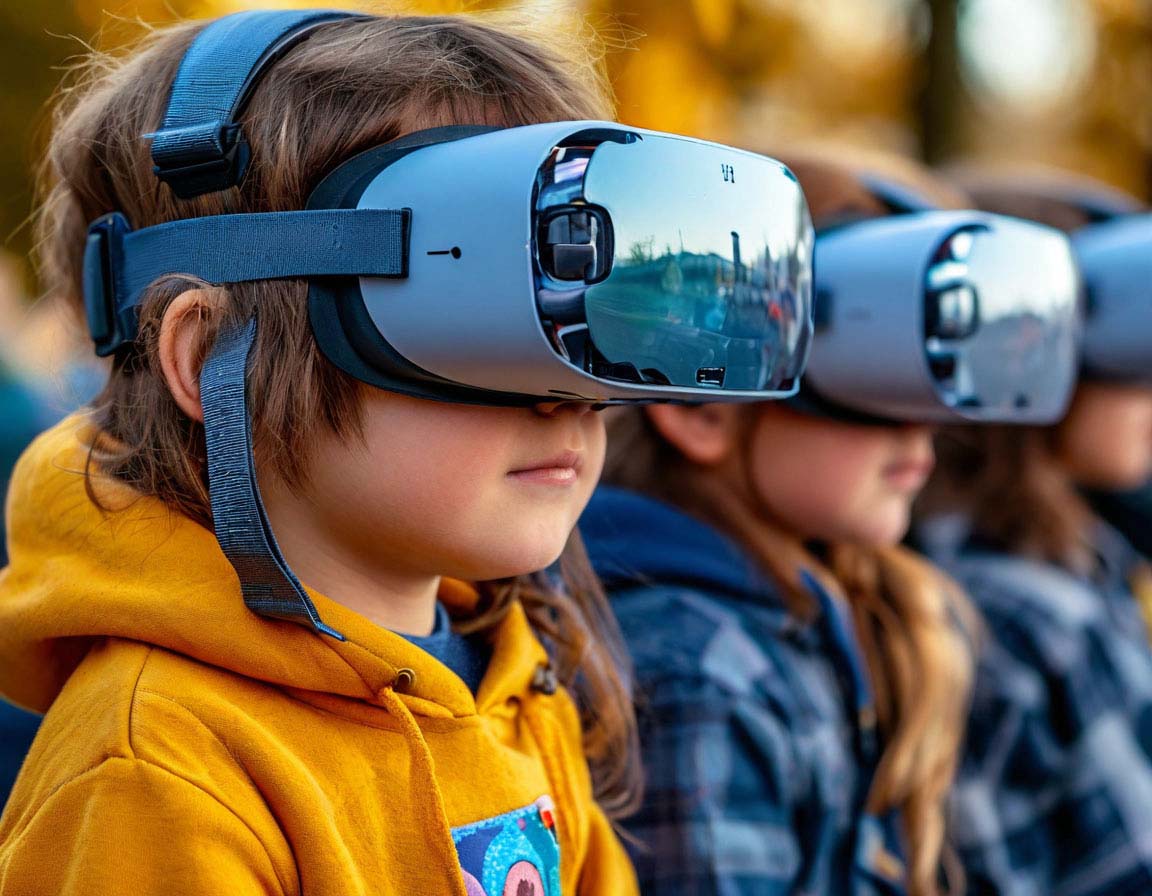Let’s Talk About VR Safety: Is Virtual Reality Safe For Kids?

The rise of VR apps and games on platforms like Meta Quest VR has sparked interest among families, but also raised serious safety concerns for children. While computer-generated environments offer engaging ways to learn and play, most VR headsets are not designed for children under the age of 13.
Understanding VR Safety for Children
Virtual reality is shaping the way children learn, play, and interact with digital environments. While the technology offers exciting possibilities, ensuring safety remains essential for healthy development and a positive experience.
What Makes VR Different from Other Screens?
Unlike TVs, tablets, or computers, it fully immerses users in a digital environment, requiring them to interact physically and visually in ways other screens do not. Key differences include:
- Immersion: The brain processes VR experiences differently, making it feel more real than traditional screen-based content.
- Close-Proximity Viewing: VR heads the eyes, which can contribute to eye strain and affect visual development in younger users.
- Physical Engagement: Many VR games and experiences require movement, increasing the risk of falls, collisions, and posture-related strain.
- Sensory Overload: The brain interprets VR differently, which may lead to dizziness, motion sickness, or confusion when transitioning back to the real world.
Why VR Safety is Important for Kids
Children’s bodies and brains are still developing, making them more susceptible to related health concerns. Extended use may contribute to vision strain, motion sickness, and posture-related issues. Additionally, the immersive nature of VR can blur the line between virtual and real, potentially influencing behavior and cognitive development.
General Safety Guidelines
- Remain Seated During Gameplay
Staying seated reduces the risk of falls and collisions. If a game requires standing, ensure children maintain balance and limit excessive movement. - Clear Your Play Area to Avoid Injuries
Remove obstacles like furniture, toys, or pets to prevent trips and collisions while using a VR headset. A clutter-free space minimizes accidents. - Use Guardian Boundaries for Physical Safety
Set up safety boundaries to alert children when they are nearing the edge of their play zone. This feature helps prevent accidental collisions with walls or objects. - Supervise Children to Prevent Misuse
Keep an eye on sessions to ensure appropriate use. Utilize parental controls to manage screen time, restrict access to certain content, and monitor online interactions. - Take Breaks to Avoid Eye Strain and Fatigue
Encourage children to take a break every 20 to 30 minutes. Short pauses help reduce visual strain, dizziness, and mental fatigue, improving overall comfort and safety.
Potential Health Concerns of VR for Kids
Virtual reality offers immersive experiences, but its impact on children’s health raises important considerations. Young users are more susceptible to issues related to vision, posture, and cognitive development. Understanding these risks can help parents create a safer VR experience.
Motion Sickness and Dizziness
Motion sickness occurs when the brain receives conflicting signals from the eyes and inner ear. This can lead to nausea, dizziness, and disorientation, especially in younger children. Symptoms may be more pronounced in fast-moving games or experiences that require rapid head movements.
To reduce motion sickness:
- Choose VR experiences with smooth, slow-motion transitions.
- Use headsets with high refresh rates to minimize lag.
- Encourage frequent breaks, especially if a child reports discomfort.
Eye Strain and Visual Development Risks
VR headsets require the eyes to focus on close-up digital screens, which may contribute to strain or fatigue. Some experts suggest that prolonged exposure may impact depth perception or eye coordination in younger children.
Ways to protect vision:
- Follow the 20-20-20 rule: Every 20 minutes, take a 20-second break and look 20 feet away.
- Adjust headset brightness and contrast to a comfortable level.
- Avoid using it in low-light environments to reduce strain.
Neck and Posture-Related Strain
VR headsets add weight to the head, which can strain the neck, shoulders, and spine, especially for younger children with developing muscles. Poor posture while using VR may lead to discomfort or long-term alignment issues.
Posture tips for safer use:
- Ensure the headset fits properly and does not put excessive pressure on the forehead.
- Encourage children to keep their backs straight and avoid slouching.
- Alternate between seated and standing VR experiences to reduce tension.
Long-Term Effects on Brain Development
Because it alters sensory input and spatial perception, some researchers are investigating its impact on brain plasticity in children. While there is no conclusive evidence of long-term harm, excessive VR exposure may influence attention spans, impulse control, and real-world perception.
To maintain cognitive balance:
- Encourage a mix of real-world and digital play.
- Use primarily for educational and interactive experiences rather than passive entertainment.
- Set time limits to ensure children engage in non-screen activities as well.
How to Prevent Potential Health Issues?
A few proactive measures can help reduce the risks associated with VR and create a safer experience for children.
Follow Age Recommendations for VR Use
Most manufacturers recommend their devices for children aged 12 and older due to potential developmental concerns. Younger children may be more sensitive to visual strain and balance issues. Parents should always check age guidelines before allowing VR use and set age-appropriate digital boundaries.
Limit Screen Time to Avoid Overexposure
Extended sessions may increase the likelihood of discomfort. The American Academy of Pediatrics suggests balancing screen time with physical and social activities.
Best practices for limiting VR time:
- Set a daily or weekly usage limit based on age and activity type.
- Encourage breaks every 20–30 minutes.
- Monitor signs of fatigue or discomfort and adjust accordingly.
Encourage Proper Posture While Using VR
Proper posture can help prevent neck and back strain. Children should sit in a comfortable, supportive chair and avoid prolonged standing sessions without breaks.
Posture tips:
- Adjust the headset straps to fit snugly but comfortably.
- Keep the screen at eye level to reduce strain on the neck.
- Encourage children to move naturally rather than holding stiff positions.
Teach Kids to Recognize Discomfort Signals
Children may not always recognize early signs of fatigue or discomfort. Teaching them to take breaks when needed can help prevent strain and motion sickness.
Encourage children to pause if they experience:
- Dizziness or nausea
- Eye discomfort or headaches
- Difficulty focusing after removing the headset
- Neck or back soreness
By implementing these strategies, parents can help make VR experiences safer, healthier, and more enjoyable for children.

Privacy and Online Safety in VR
Virtual reality creates immersive digital spaces where children can interact with others, explore new environments, and engage in learning experiences. However, the online nature of many VR platforms introduces risks such as exposure to strangers, data privacy concerns, and inappropriate content. Parents play a crucial role in ensuring a safe and secure experience for their children.
Managing Stranger Interactions in Multiplayer Games
Many VR games include multiplayer features, allowing users to communicate with others worldwide. While this can be a fun social experience, it also exposes children to strangers, unmoderated conversations, and potentially harmful interactions.
Steps to manage online interactions safely:
- Use Private or Friends-Only Modes: Many VR games offer private lobbies where kids can play only with approved friends.
- Disable Voice and Text Chat When Possible: If a game doesn’t require communication, turning off these features reduces exposure to strangers.
- Educate Kids on Online Etiquette: Teach children to avoid sharing personal information and to report inappropriate behavior.
- Monitor Interactions Regularly: Stay aware of who your child is playing with and review game settings frequently.
Parental Controls and Monitoring Tools
VR platforms and headsets include parental control options to limit access to certain content, monitor playtime, and restrict online interactions.
Key parental control features to utilize:
- Content Filtering: Block games or experiences that are not age-appropriate.
- Screen Time Limits: Set daily or weekly usage restrictions to prevent overexposure.
- Activity Reports: Some systems provide insights into what games or apps children are using.
- Account Restrictions: Require approval before downloading new games or making in-app purchases.
Protecting Personal Data in Virtual Worlds
VR experiences often collect user data, including movement tracking, voice recordings, and behavioral patterns. Ensuring children’s privacy requires careful settings adjustments and awareness of how data is handled.
Ways to protect privacy:
- Use Child-Specific Accounts: Many platforms allow restricted child accounts with limited data collection.
- Adjust Privacy Settings: Disable data-sharing features and limit access to personal information.
- Avoid Connecting Social Media Accounts: Keeping VR profiles separate from other online identities adds an extra layer of security.
- Regularly Review Privacy Policies: Stay informed about how VR companies handle user data.

Choosing the Right VR Content for Kids
Not all VR experiences are designed with children in mind. Some may contain intense visuals, violent content, or complex interactions that aren’t suitable for young users. Choosing the right content ensures a fun and safe experience.
What Makes VR Content Age-Appropriate?
Age-appropriate content should align with a child’s developmental stage, attention span, and ability to process immersive experiences.
Factors to consider when selecting content:
- ESRB or PEGI Ratings: Check content ratings to ensure suitability for your child’s age.
- Educational Value: Look for games that encourage learning, creativity, and problem-solving.
- Comfort Level: Choose experiences with minimal motion to prevent dizziness or disorientation.
- Parental Reviews: Read reviews from other parents to assess content safety and engagement.
Best Educational VR Games for Kids
VR can be an excellent learning tool, offering interactive experiences that make education engaging. Some of the best educational VR games include:
- Google Earth VR: Allows children to explore different locations worldwide.
- Tilt Brush: Encourages creativity with immersive 3D painting.
- National Geographic Explore VR: Provides interactive wildlife and geography experiences.
- Mission: ISS: Teaches kids about space exploration by simulating life on the International Space Station.
Avoiding Inappropriate or Harmful VR Experiences
Some content may be too intense, violent, or psychologically overwhelming for children. Ensuring a safe experience requires careful screening.
Steps to avoid harmful VR content:
- Pre-View Games Before Play: Test content before allowing children to use it.
- Set Store Purchase Restrictions: Prevent children from downloading unapproved games.
- Monitor Gameplay: Stay nearby during sessions to ensure children engage with appropriate content.
- Use Kid-Friendly VR Platforms: Some ecosystems cater specifically to children, offering safer content selections.
What to Look for in a Child-Friendly VR Headset
The right headset should prioritize comfort, safety, and content accessibility.
Features to consider:
- Lightweight Design: Reduces strain on a child’s neck.
- Adjustable Fit: Ensures proper alignment for safe viewing.
- Parental Controls: Allows for easy monitoring and restriction settings.
- Screen Refresh Rate: Higher refresh rates (90Hz or above) reduce motion sickness.
Recommended VR Headsets for Different Age Groups
Selecting an age-appropriate headset ensures children have a safe and comfortable experience.
- Ages 6-10: Meta Quest 2 (with parental controls enabled), Nintendo Labo VR Kit (designed for casual play).
- Ages 11-13: Meta Quest 3, Pico 4 (offers a balance between safety and functionality).
- Ages 14+: PlayStation VR2, HTC Vive XR Elite (advanced features suitable for older kids and teens).
VR Headsets with Built-In Safety Features
Some headsets offer built-in tools to enhance safety and parental control.
- Meta Quest Guardian System: Creates boundaries to prevent collisions.
- HTC Vive Eye Comfort Settings: Reduces blue light and adjusts display for visual comfort.
- PlayStation VR2 Child Lock Features: Restricts access to age-inappropriate content.
“Virtual reality is the ‘ultimate empathy machine.’ These experiences are more than documentaries. They’re opportunities to walk a mile in someone else’s shoes.” — Chris Milk
VR Headset Age Limits and Manufacturer Guidelines
Virtual reality offers exciting experiences, but not all headsets are suitable for children. Manufacturers set age recommendations based on potential health risks, including vision strain, motion sickness, and cognitive effects. Understanding these guidelines helps ensure a safer VR experience for kids.
Why Age Restrictions Exist for VR Headsets
Most manufacturers advise against use by young children due to developmental concerns. The primary reasons for age limits include:
- Vision Development: Prolonged close-range screen exposure may affect depth perception and eye coordination in younger children.
- Motion Sensitivity: Children are more prone to motion sickness due to their developing vestibular systems.
- Cognitive Effects: VR’s immersive nature can impact how young users perceive reality and process spatial awareness.
- Headset Fit and Comfort: Most headsets are designed for adult-sized heads, which can cause strain on a child’s neck and posture.
Manufacturer Recommendations for Kids’ VR Use
Each company sets its own age guidelines based on hardware design and potential health effects.
- Meta Quest 2 & 3: Recommended for ages 13 and up.
- PlayStation VR2: Suggested for users aged 12 and older.
- HTC Vive & Vive Pro: Generally not recommended for children under 13.
- Pico 4: Advised for ages 13 and above.
- Nintendo Labo VR Kit: Designed for younger users, recommended for ages 7 and up.
Parents should follow these recommendations to reduce potential risks associated with VR use.
Potential Risks of Ignoring Age Guidelines
Ignoring manufacturer age limits may lead to:
- Increased Eye Strain: Younger children’s eyes are still developing, making them more susceptible to fatigue and strain from close-up screens.
- Postural Issues: Heavy headsets may cause discomfort and lead to poor posture over time.
- Difficulty Distinguishing Reality from VR: Children under a certain age may struggle with differentiating virtual experiences from real-world interactions.
- Higher Risk of Motion Sickness: Younger users may experience dizziness or nausea more frequently than older children or adults.
Following recommended guidelines ensures that VR use remains a positive and developmentally appropriate experience.
“Virtual reality sort of encloses and immerses the person into an experience that can be really cool but probably has a lower commercial interest over time. Less people will be interested in that, but there are some really cool areas there for education and gaming that we have a lot of interest in.” — Tim Cook

The Future of VR Safety for Kids
As VR technology evolves, manufacturers continue improving safety features to accommodate younger users. Innovations in software and hardware are making VR more accessible and less physically demanding.
How VR Technology is Evolving for Safer Use
New advancements are helping to address some of the concerns associated with VR for children:
- Lighter and More Adjustable Headsets: Future designs aim to reduce weight and improve ergonomic fit for smaller users.
- Eye-Tracking Technology: Some headsets, like the PlayStation VR2, include eye-tracking features that help reduce strain and improve user comfort.
- Adaptive Motion Settings: More games now offer comfort modes that limit rapid movement to prevent motion sickness.
- Blue Light Reduction: Newer screens reduce exposure to high-energy blue light, minimizing eye strain.
What Parents Should Expect from Upcoming VR Innovations
VR becomes more integrated into education and entertainment and manufacturers are prioritizing child-friendly adaptations. Parents can expect:
- More Robust Parental Controls: Advanced monitoring features that allow parents to track usage, filter content, and set playtime limits.
- Educational VR Growth: More developers are creating immersive learning experiences tailored to children.
- Kid-Safe VR Hardware: Some companies are exploring lighter headsets with built-in safety features for younger users.
- Improved Safety Guidelines: Ongoing research will likely lead to clearer, evidence-based recommendations for VR use among children.
By staying informed about VR advancements, parents can make educated decisions on when and how their children engage with virtual reality in a safe and beneficial way.
To find more authoritative information on VR safety, consider the following resources:
- Meta Quest Safety Center: Provides comprehensive guidelines on safe VR usage, including health precautions and parental controls.
- User Safety in AR/VR: Protecting Kids: An in-depth report by the Information Technology and Innovation Foundation discussing safety considerations for children using AR and VR technologies.
Parents Also Ask
What is the recommended age to use VR?
Most manufacturers recommend VR for ages 12 and up due to potential vision strain, motion sickness, and cognitive development concerns.
Is VR OK for kids’ eyes?
Moderate use is generally safe, but prolonged exposure may cause eye strain, fatigue, or impact depth perception. Frequent breaks help reduce risks.
Is Oculus OK for a 7-year-old?
No, Meta recommends Oculus (Quest) for ages 13+. Younger children may experience discomfort, and the headset may not fit properly.
